Smart Public Lighting Control and Measurement System Using LoRa Network
Abstract
1. Introduction
- -
- Design of our own system to improve energy efficiency in public lighting. Three device, namely the MCDSL, LLMD, and GWLN, have been developed.
- -
- These devices are low cost and open source, and were evaluated successfully.
- -
- Monitoring and control of a public lighting system using the EESL algorithm implemented in MCDSL, with communication via a LoRa network controlled by GWLN.
2. Theory Description
2.1. System Requirements
2.2. LoRa Network
- CF is the centre frequency used for the transmission band. For the SX1276/SX1276 transceiver, and is in the range of 433 MHz in Asia, 868 MHz in Europe, and 915 MHz in North America.
- SF provides a trade-off between data rate and range. The choice of higher spreading factor can increase the range but decreases the data rate and vice versa. LoRa employs multiple orthogonal spreading factors (between 7 to 12).
- BW: Transmitter sends the widespread data at a chip rate equal to the system bandwidth in chips per-second-per-Hertz. LoRa can only be chosen among three options: 125, 250, or 500 kHz.
- CR: Forward error correction (FEC) techniques are used in Lora to further increase the receiver sensitivity. Code rate defines the amount of FEC. The coding rate expression is CR = , n is from 1 to 4. It denotes that every four useful bits are encoded by 5, 6, 7, or 8 transmission bits.
2.3. EESL Algorithm
3. Street Lights System Design
3.1. Hardware
3.1.1. GWLN Design
3.1.2. MCDSL Design
3.1.3. LLMD Design
3.1.4. Components
- AUR3 in GWLN and LLMD: the AUR3 development board, used in GWLN and LLMD, is based on the ATmega328P microcontroller, equipped with an open-source platform for electronic prototypes. The characteristics of AUR3 board are presented in [44].
- AMR3 in MCDSL: in MCDSL has been chosen as the core with the development board AMR3, which is based on the ATmega2560 microcontroller, which like ATmega328P has open-source platform for developing electronic prototypes. The characteristics of DLS can be seen in [49].
- WMP in GWLN: cloud access GWLN uses WMP based on the ESP-8266X microcontroller that allows access to the Wi-Fi network. The microcontroller is compatible with the Arduino development environment, with the open-source possibilities it offers. The characteristics of DLS are available in [46].
3.2. Software Design
3.2.1. GWLN Program
3.2.2. MCDSL Program
3.2.3. LLMD Program
3.2.4. WMP Program
4. Result and Discussion
4.1. Test Equipment
4.2. Measurement Level Illumination
4.3. Development of Energy Saving Strategies
Pedestrian Distribution
4.4. LoRa System Performance
4.5. Dayly Electrical Variables
4.6. Annual Energy Saving of Street Lights
5. Conclusions
Author Contributions
Funding
Acknowledgments
Conflicts of Interest
Abbreviations
| AMR3 | Arduino Mega R3 |
| AUR3 | Arduino Uno R3 |
| BW | Bandwidth |
| CF | Carrier Frequency |
| CR | Code Rate |
| CRC | Cyclic Redundancy Check |
| DLS | Dragino LoRa Shield |
| DLGS | Dragino LoRa GPS Shield |
| E | Active energy |
| EE | Energy Efficiency |
| EESL | Energy Efficiency for Street Lights |
| FEC | Forward error correction |
| GPS | Global Positioning System |
| GWLN | GateWay LoRa Network |
| LLMD | Lighting Level Measurement Device |
| I2C | Inter-Integrated Circuit |
| IoT | Internet of Things |
| L | Level |
| LED | Light Emitting Diode |
| LLMD | Lighting Level Measurement Device |
| LoRa | Long Range |
| LoRaWAN | Long Range Wide Area Network |
| LPWAN | Low Power Wide Area Network |
| MCDSL | Measure and Control Device for Street Lights |
| N | Number |
| P | Active power |
| PIR | Passive infrared |
| PF | Power factor |
| PL | PayLoad |
| PLR | Packet Lost Rate |
| PZEM | PZEM-004t |
| RMS | Root Mean Square |
| RSSI | Received Signal Strength Indicator |
| SF | Spreading Factor |
| SL | Street Light |
| SNR | Signal-to-Noise Ratio |
| t | Time |
| ToA | Time on Air |
| Wi-Fi | Wireless Fidelity |
| WMP | Arduino Wemos Mini Pro |
| WNS | Wireless Sensor Networks |
| Greek symbols | |
| ε | Measuring error |
| µ | mean |
| σ | standard deviation |
| Subscripts | |
| b | baseline |
| cur | actual |
| lev | level |
| min | minimum |
| max | maximum |
| ppreamble | |
| pe | operation equivalent |
| PHY | symbols transmitted in the physical message |
| pk | packet |
| r | reduced |
| sav | saved |
| sym | symbol |
| thre | threshold |
References
- Kabalci, Y.; Ersan Kabalci, E.; Padmanaban, S.; Holm-Nielsen, J.B.; Blaabjerg, F. Internet of Things Applications as Energy Internet in Smart Grids and Smart Environments. Electronics 2019, 8, 972. [Google Scholar] [CrossRef]
- Weber, M.; Podnar Žarko, I. A Regulatory View on Smart City Services. Sensors 2019, 19, 415. [Google Scholar] [CrossRef] [PubMed]
- Wojnicki, I.; Komnata, K.; Kotulski, L. Comparative Study of Road Lighting Efficiency in the Context of CEN/TR 13201 2004 and 2014 Lighting Standards and Dynamic Control. Energies 2019, 12, 1524. [Google Scholar] [CrossRef]
- Kostic, M.; Djokic, L. Recommendations for energy efficient and visually acceptable street lighting. Energy 2009, 34, 1565–1572. [Google Scholar] [CrossRef]
- Sedziwy, A.; Kotulski, L. Towards Highly Energy-Efficient Roadway Lighting. Energies 2016, 9, 263. [Google Scholar] [CrossRef]
- Beccali, M.; Bonomolo, M.; Ciulla, G.; Galatioto, A.; Lo Brano, V. Improvement of energy efficiency and quality of street lighting in South Italy as an action of Sustainable Energy Action Plans. The case study of Comiso (RG). Energy 2015, 92, 394–408. [Google Scholar] [CrossRef]
- Gutierrez-Escolar, A.; Castillo-Martinez, A.; Gomez-Pulido, J.M.; Gutierrez-Martinez, J.M.; Stapic, Z.; Medina-Merodio, J.A. A Study to Improve the Quality of Street Lighting in Spain. Energies 2015, 8, 976–994. [Google Scholar] [CrossRef]
- Carli, R.; Dotoli, M.; Pellegrino, R. A decision-making tool for energy efficiency optimization of street lighting. Comput. Oper. Res. 2018, 96, 222–234. [Google Scholar] [CrossRef]
- Sikora, R.; Markiewicz, P.; Pabjanczyk, W. Computing Active Power Losses Using a Mathematical Model of a Regulated Street Luminaire. Energies 2018, 11, 1386. [Google Scholar] [CrossRef]
- Djuretic, A.; Kostic, M. Actual energy savings when replacing high-pressure sodium with LED luminaires in street lighting. Energy 2018, 157, 367–378. [Google Scholar] [CrossRef]
- Yao, J.; Zhang, Y.; Yan, Z.; Li, L. A Group Approach of Smart Hybrid Poles with Renewable Energy, Street Lighting and EV Charging Based on DC Micro-Grid. Energies 2018, 11, 3445. [Google Scholar] [CrossRef]
- Bellido-Outeiriño, F.J.; Quiles-Latorre, F.J.; Moreno-Moreno, C.D.; Flores-Arias, J.M.; Moreno-García, I.; Ortiz-López, M. Streetlight Control System Based on Wireless Communication over DALI Protocol. Sensors 2016, 16, 597. [Google Scholar] [CrossRef] [PubMed]
- Hadipour, M.; Farrokhi Derakhshandehb, J.; Aghazadeh Shiranc, M.; Rezaei, R. Automatic washing system of LED street lighting via Internet of Things. Internet Things 2018, 1, 74–80. [Google Scholar] [CrossRef]
- Mohandasa, P.; Sheebha, J.; Dhanarajb, A.; Xiao-Zhi, G. Artificial Neural Network based Smart and Energy Efficient Street Lighting System: A Case Study for Residential area in Hosur. Sustain. Cities Soc. 2019, 48, 101499. [Google Scholar] [CrossRef]
- Mumtaz, Z.; Ullah, S.; Ilyas, Z.; Aslam, N. An Automation System for Controlling Streetlights and Monitoring Objects Using Arduino. Sensors 2018, 18, 3178. [Google Scholar] [CrossRef]
- Kaminska, A.; Ozadowicz, A. Lighting Control Including Daylight and Energy Efficiency Improvements Analysis. Energies 2018, 11, 2166. [Google Scholar] [CrossRef]
- Castillo-Martinez, A.; Medina-Merodio, J.A.; Gutierrez-Martinez, J.M.; Aguado-Delgado, J.; de-Pablos-Heredero, C.; Otón, S. Evaluation and Improvement of Lighting Efficiency in Working Spaces. Sustainability 2018, 10, 1110. [Google Scholar] [CrossRef]
- Ping Lau, S.; Merrett, G.V.; Weddell, A.S.; Neil, M. White A traffic-aware street lighting scheme for Smart Cities using autonomous networked sensors. Comput. Electr. Eng. 2015, 45, 192–207. [Google Scholar]
- Jagadeesha, Y.M.; Akilesha, S.; Karthika, S. Prasantha Intelligent Street Lights. Procedia Technol. 2015, 21, 547–551. [Google Scholar] [CrossRef]
- Sánchez, L.; Elicegui, I.; Cuesta, J.; Muñoz, L.; Lanza, J. Integration of Utilities Infrastructures in a Future Internet Enabled Smart City Framework. Sensors 2013, 13, 14438–14465. [Google Scholar] [CrossRef]
- Wojnicki, I.; Kotulski, L. Improving Control Efficiency of Dynamic Street Lighting by Utilizing the Dual Graph Grammar Concept. Energies 2018, 11, 402. [Google Scholar] [CrossRef]
- Kovacs, A.; Batai, R.; Csan, B.; Dudas, P.; Haya, B.; Pedone, G.; Revesz, T.; Vancza, J. Intelligent control for energy-positive street lighting. Energy 2016, 114, 40–51. [Google Scholar] [CrossRef]
- Elejoste, P.; Angulo, I.; Perallos, A.; Chertudi, A.; García Zuazola, I.J. An Easy to Deploy Street Light Control System Based on Wireless Communication and LED Technology. Sensors 2013, 13, 6492–6523. [Google Scholar] [CrossRef] [PubMed]
- Ożadowicz, A.; Grela, J. Energy saving in the street lighting control system—A new approach based on the EN-15232 standard. Energy Effic. 2017, 10, 563–576. [Google Scholar] [CrossRef]
- Leccese, F.; Cagnetti, M.; Trinca, D. A Smart City Application: A Fully Controlled Street Lighting Isle Based on Raspberry-Pi Card, a ZigBee Sensor Network and WiMAX. Sensors 2014, 14, 24408–24424. [Google Scholar] [CrossRef]
- Rabaza, O.; Molero-Mesa, E.; Aznar-Dols, F.; Gómez-Lorente, D. Experimental Study of the Levels of Street Lighting Using Aerial Imagery and Energy Efficiency Calculation. Sustainability 2018, 10, 4365. [Google Scholar] [CrossRef]
- Pasolini, G.; Buratti, C.; Feltrin, L.; Flavio Zabini, F.; De Castro, C.; Verdone, R.; Andrisano, O. Smart City Pilot Projects Using LoRa and IEEE802.15.4 Technologies. Sensors 2018, 18, 1118. [Google Scholar] [CrossRef]
- LPWA Technologies Unlock New IoT Market Potential. Machina Research. Nov. 2015. Available online: https://www.lora-alliance.org/portals/0/documents/whitepapers/LoRa-Alliance-Whitepaper-LPWA-Technologies.pdf (accessed on 10 December 2019).
- Vangelista, L.; Zanella, A.; Zorzi, M. Long-Range IoT Technologies: The Dawn of LoRa. Future Access Enablers of Ubiquitous and Intelligent Infrastructures; Springer: Berlin/Heidelberg, Germany, 2015; pp. 51–58. [Google Scholar]
- LoRa Alliance. Available online: https://lora-alliance.org (accessed on 10 December 2019).
- De Carvalho Silva, J.; Rodrigues, J.J.P.C.; Alberti, A.M.; Solic, P.; Aquino, A.L.L. LoRaWAN—A Low Power WAN Protocol for Internet of Things: A Review and Opportunities. In Proceedings of the 2nd International Multidisciplinary Conference on Computer and Energy Science (SpliTech), Split, Croatia, 12–14 July 2017. [Google Scholar]
- Wydra, M.; Kubaczynski, P.; Mazur, K.; Ksiezopolski, B. Time-Aware Monitoring of Overhead Transmission Line Sag and Temperature with LoRa Communication. Energies 2019, 12, 505. [Google Scholar] [CrossRef]
- Angrisani, L.; Bonavolontà, F.; Liccardo, A.; Schiano, R. On the Use of LoRa Technology for Logic Selectivity in MV Distribution Networks. Energies 2018, 11, 3079. [Google Scholar] [CrossRef]
- Paredes-Parra, J.M.; García-Sánchez, A.J.; Mateo-Aroca, A.; Molina-García, A. An Alternative Internet-of-Things Solution Based on LoRa for PV Power Plants: Data Monitoring and Management. Energies 2019, 12, 881. [Google Scholar] [CrossRef]
- Cano-Ortega, A.; Sánchez-Sutil, F.J. Monitoring of the Efficiency and Conditions of Induction Motor Operations by Smart Meter Prototype Based on a LoRa Wireless Network. Electronics 2019, 8, 1040. [Google Scholar] [CrossRef]
- CEN/TR 13201e1:2014, Light and Lighting, Road Lighting e Part 1: Performance Requirements. Available online: https://www.en-standard.eu/csn-en-13201-1-4-road-lighting/ (accessed on 10 December 2019).
- DIN EN 13201-2: 2016—Road Lighting—Part 2: Performance Requirement. Available online: https://www.en-standard.eu/csn-en-13201-1-4-road-lighting/ (accessed on 10 December 2019).
- Noreen, U.; Bounceur, A.; Clavier, L. A Study of LoRa Low Power and Wide Area Network Technology. In Proceedings of the International Conference on Advanced Technologies for Signal and Image Processing (ATSIP), Fez, Morocco, 22–24 May 2017. [Google Scholar]
- Phung, K.H.; Hieu Tran, H.; Nguyen, Q. Analysis and Assessment of LoRaWAN. In Proceedings of the 2nd International Conference on Recent Advances in Signal Processing, Telecommunications & Computing (SigTelCom), Ho Chi Minh, Vietnam, 29–31 January 2018. [Google Scholar]
- Bouguera, T.; Diouris, J.F.; Chaillout, J.J.; Jaouadi, R.; Andrieux, G. Energy Consumption Model for Sensor Nodes Based on LoRa and LoRaWAN. Sensors 2018, 18, 2104. [Google Scholar] [CrossRef] [PubMed]
- Polonelli, T.; Brunelli, D.; Marzocchi, A.; Benini, L. Slotted ALOHA on LoRaWAN-Design. Analysis and Deployment. Sensors 2019, 19, 838. [Google Scholar] [CrossRef]
- Sornin, N.; Yegin, A. LoRaWANTM 1.1 Specification. 2017. Available online: https://lora-alliance.org/sites/default/files/2018-04/lorawantm_specification_-v1.1.pdf (accessed on 10 December 2019).
- LoRa Alliance Technical Committee Regional Parameters Workgroup. LoRaWANTM 1.1 Regional Parameters. 2018. Available online: https://lora-alliance.org/sites/default/files/2018-04/lorawantm_regional_parameters_v1.1rb_-_final.pdf (accessed on 10 December 2019).
- Arduino Home. Available online: https://store.arduino.cc/arduino-uno-rev3 (accessed on 15 October 2019).
- Dragino LoRa Shield for Arduino. Available online: https://www.dragino.com/products/module/item/102-lora-shield.html (accessed on 10 December 2019).
- Wemos Electronics. Available online: https://wiki.wemos.cc/products:d1:d1_mini_pro (accessed on 10 December 2019).
- Dragino LoRa GPS Shield for Arduino. Available online: http://www.dragino.com/products/lora/item/108-lora-gps-shield.html (accessed on 10 December 2019).
- Ningbo Peacefair Electronic Co., Ltd. Available online: https://peacefair.en.made-in-china.com (accessed on 10 December 2019).
- Arduino Mega Rev3. Available online: https://store.arduino.cc/mega-2560-r3 (accessed on 10 December 2019).
- RobotDyn AC Dimmer. Available online: https://robotdyn.com/ac-light-dimmer-module-1-channel-3-3v-5v-logic-ac-50-60hz-220v-110v.html (accessed on 10 December 2019).
- Adafruit TSL2561. Available online: https://www.adafruit.com/product/439 (accessed on 10 December 2019).
- Arduino MKR WAN 1300. Available online: https://store.arduino.cc/mkr-wan-1300 (accessed on 10 December 2019).
- Monteino. Available online: https://lowpowerlab.com/guide/moteino/ (accessed on 10 December 2019).
- Lopy4. Available online: https://docs.pycom.io/gettingstarted/connection/lopy4/ (accessed on 10 December 2019).
- Libelium. Available online: http://www.libelium.com/extreme-range-wireless-sensors-connectivity-through-buLLMDings-in-city-lora-868mhz-915mhz/ (accessed on 10 December 2019).
- Dragino LoRa Products. Available online: http://www.dragino.com/products/lora.html (accessed on 22 June 2019).
- Murata Electronics. Available online: https://wireless.murata.com/pub/RFM/data/type_abz.pdf (accessed on 10 December 2019).
- HOPERF Chip RFM95/96/97/98. Available online: https://cdn.sparkfun.com/assets/learn_tutorials/8/0/4/RFM95_96_97_98W.pdf (accessed on 10 December 2019).
- Semtech SX1276. Available online: https://www.semtech.com/products/wireless-rf/lora-transceivers/sx1276 (accessed on 10 December 2019).
- Semtech SX1272. Available online: https://www.semtech.com/products/wireless-rf/lora-transceivers/sx1272 (accessed on 10 December 2019).
- ACS712. Available online: https://www.sparkfun.com/datasheets/BreakoutBoards/0712.pdf (accessed on 10 December 2019).
- STC013 Dechang Electronics Co. Ltd. Available online: http://en.yhdc.com/product/SCT013-401.html (accessed on 10 December 2019).
- FZ0430 Voltage Sensor. Available online: http://www.ekt2.com/pdf/412_ARDUINO_SENSOR_VOLTAGE_DETECTOR.pdf (accessed on 10 December 2019).
- ZMPT101B Voltage Sensor. Available online: https://www.datasheet4u.com/datasheet-pdf/ETC/ZMPT101B/pdf.php?id=1031464 (accessed on 10 December 2019).
- Sánchez-Sutil, F.; Cano-Ortega, A.; Hernández, J.C.; Rus-Casas, C. Development and calibration of an open source, low-cost power smart meter prototype for PV household-prosumers. Electronics 2019, 8, 878. [Google Scholar] [CrossRef]
- Cano-Ortega, A.; Sánchez-Sutil, F.J.; Hernández, J.C. Power Factor Compensation using Teaching Learning Based Optimization and Monitoring System by Cloud Data Logger. Sensors 2019, 19, 2172. [Google Scholar] [CrossRef] [PubMed]
- BH1750 Illumination Sensor. Available online: http://rohmfs.rohm.com/en/products/databook/datasheet/ic/sensor/light/bh1721fvc-e.pdf (accessed on 10 December 2019).
- BTA16-600B Triac. Available online: https://www.alldatasheet.com/datasheet-pdf/pdf/440942/ISC/BTA16-600B.html (accessed on 10 December 2019).
- PIR Sensor LHI1778. Available online: https://www.alldatasheet.com/datasheet-pdf/pdf/14901/PERKINELMER/LHI778.html (accessed on 10 December 2019).
- BISS0001 Integrated Circuit. Available online: https://www.alldatasheet.com/datasheet-pdf/pdf/88732/ETC/BISS0001.html (accessed on 10 December 2019).
- HC-SR501 Motion Sensor. Available online: https://www.mpja.com/download/31227sc.pdf (accessed on 10 December 2019).
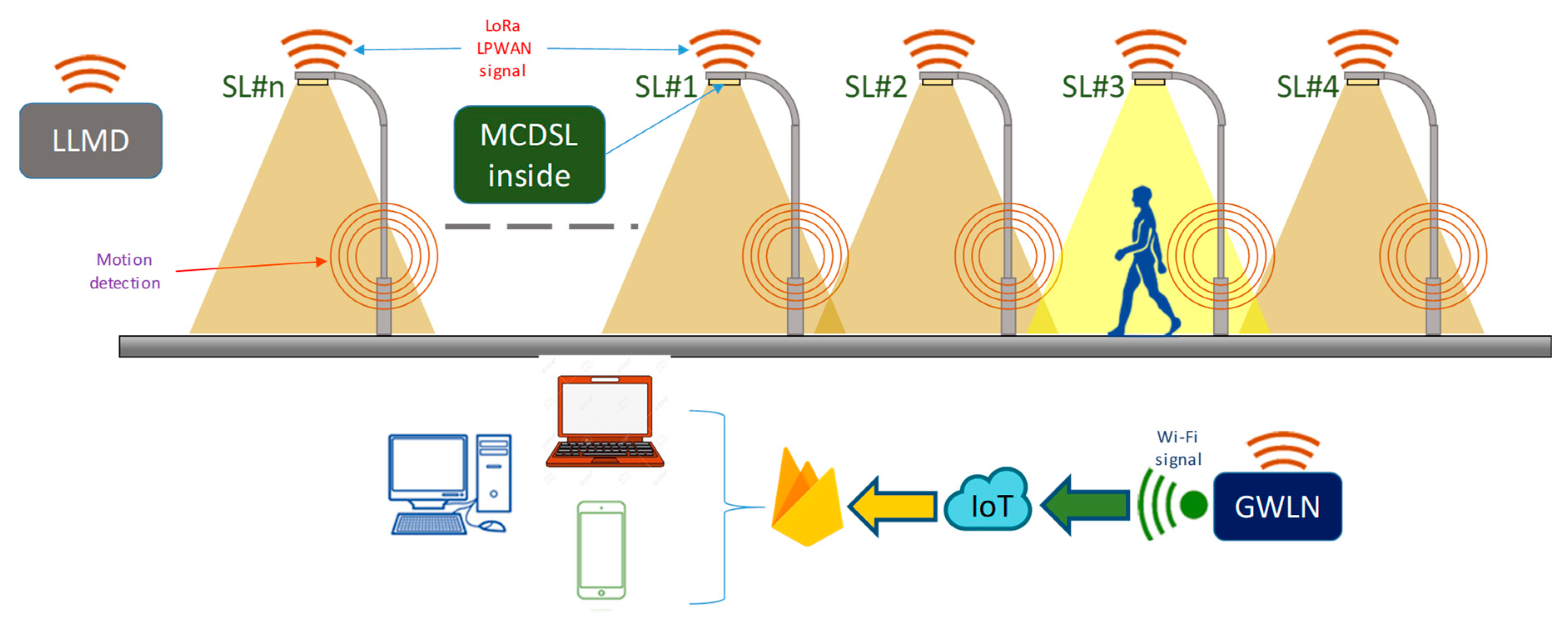
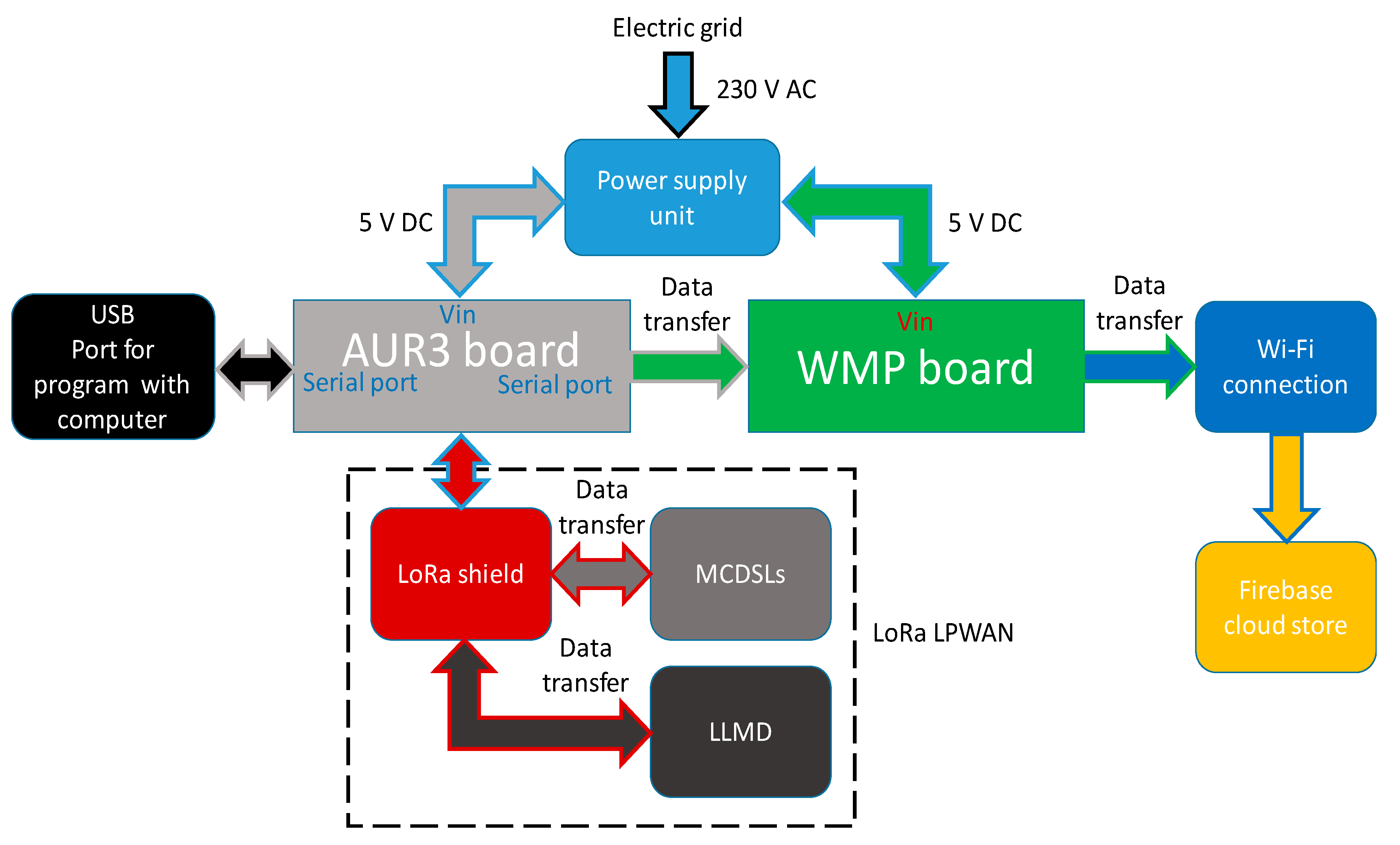
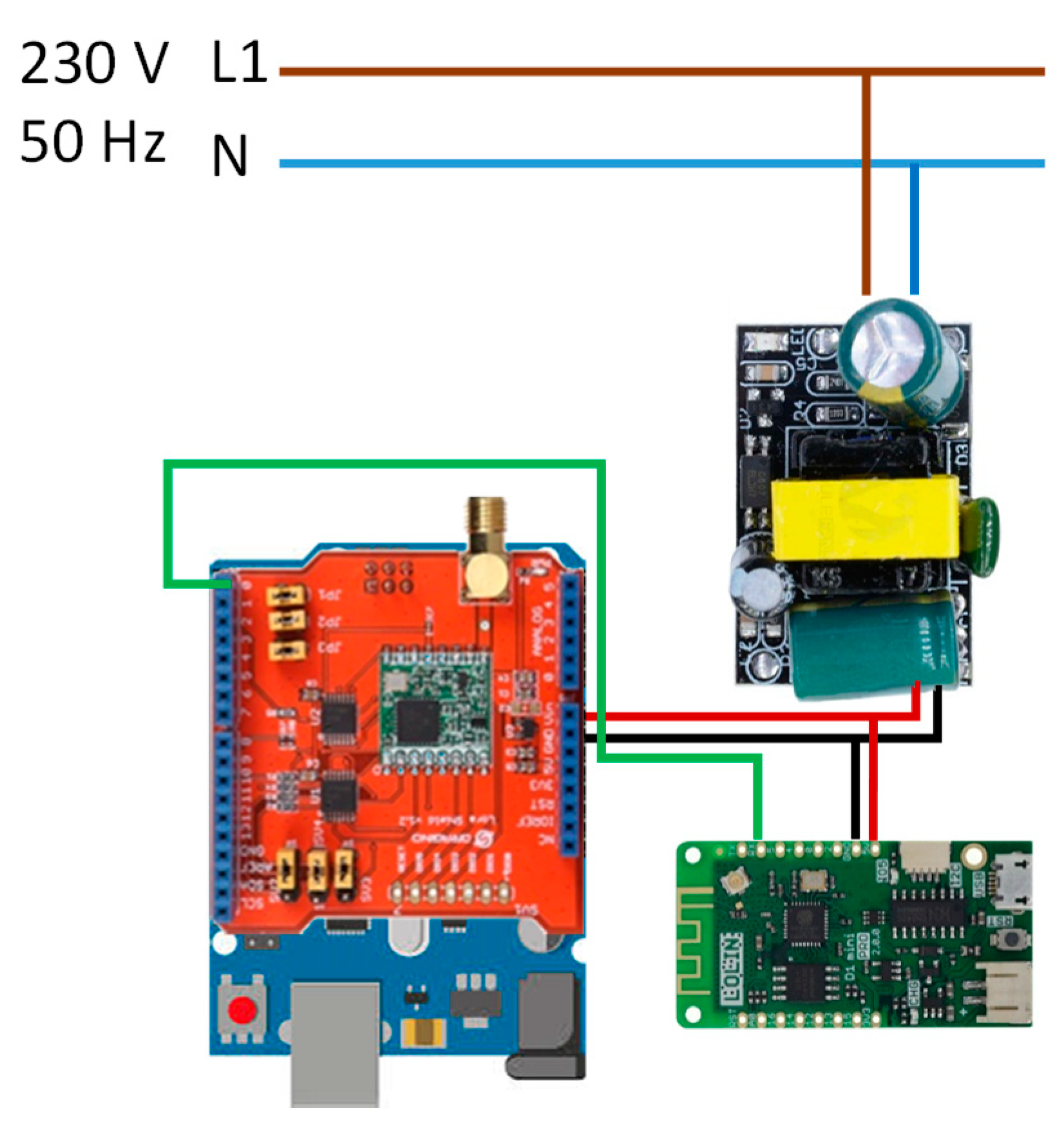
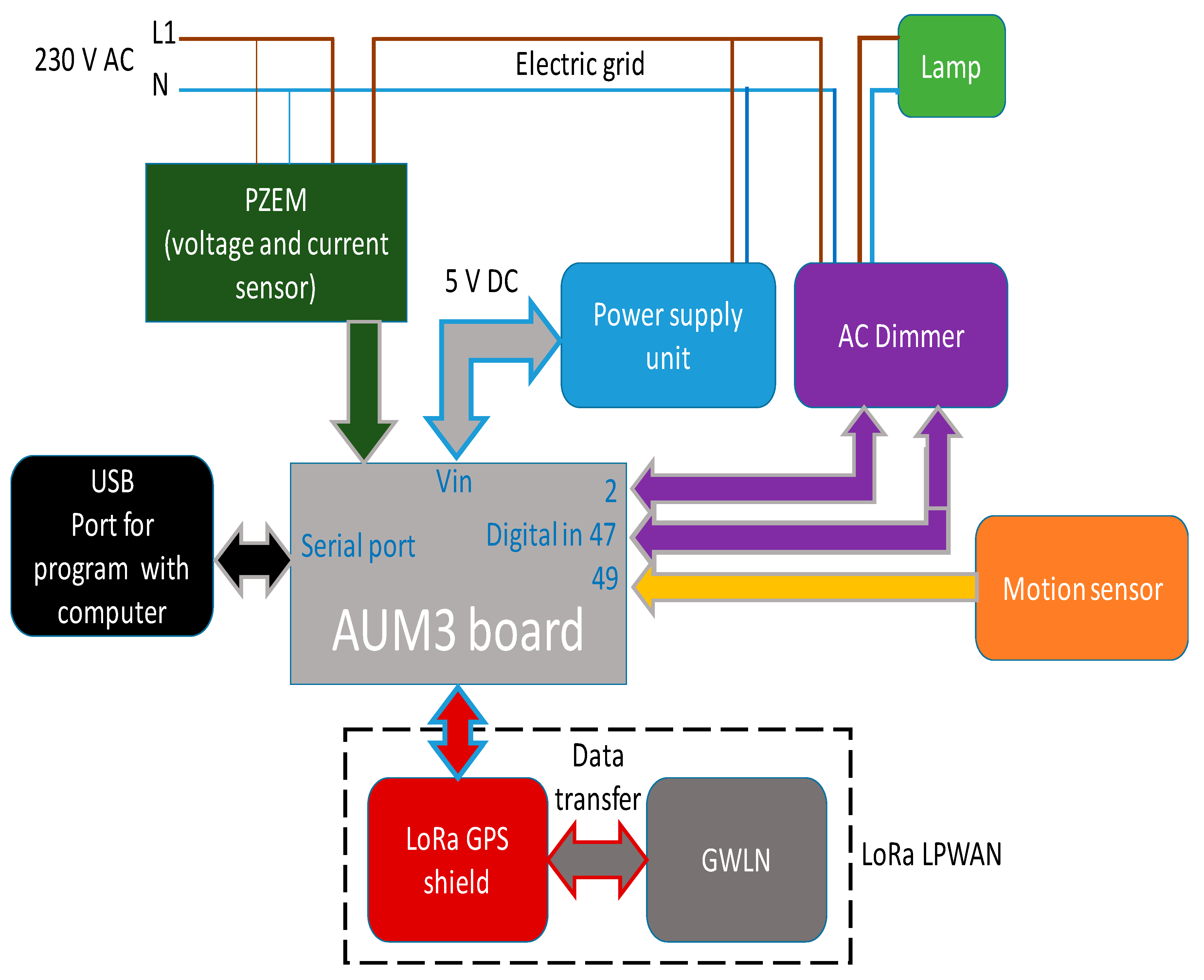
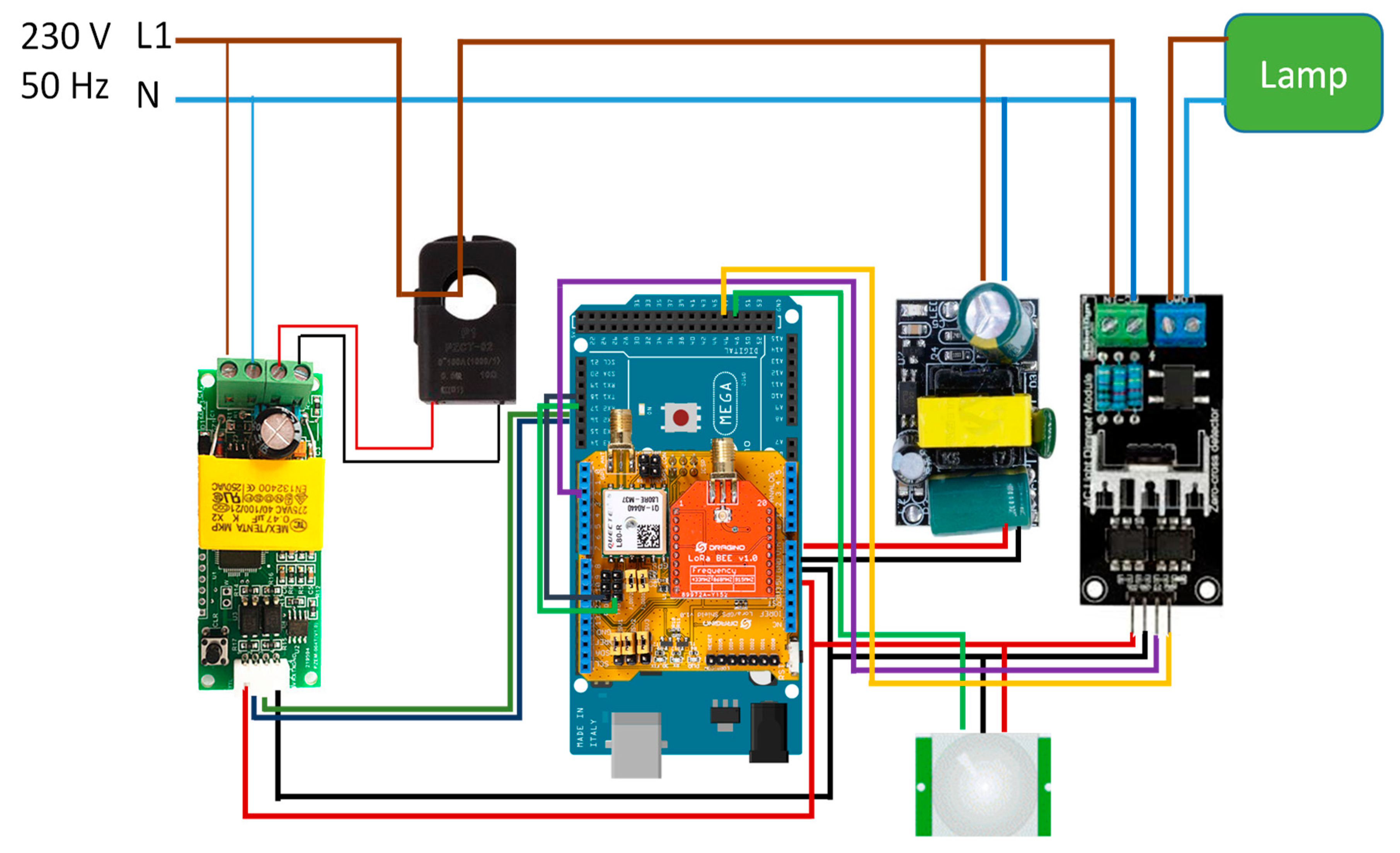
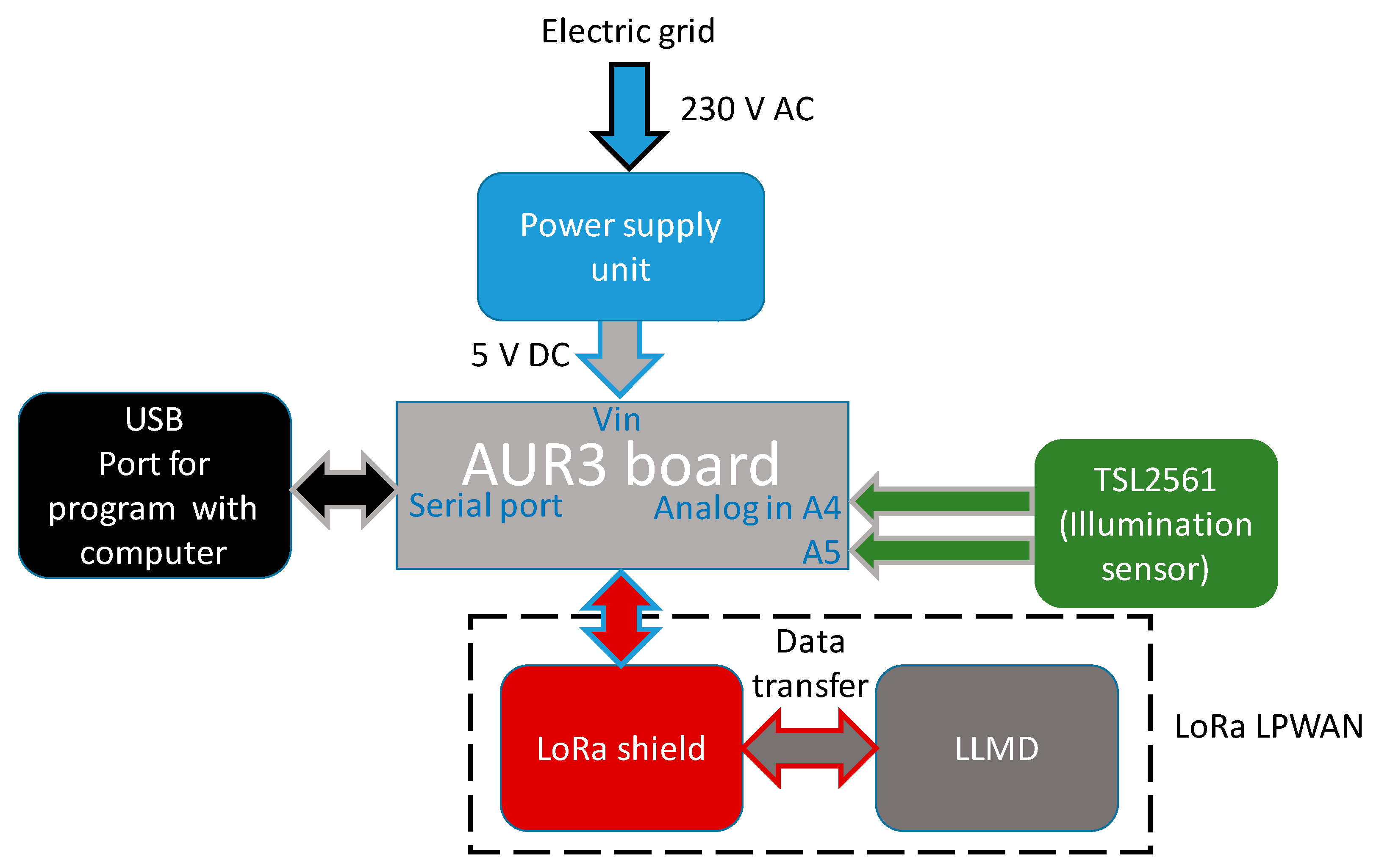
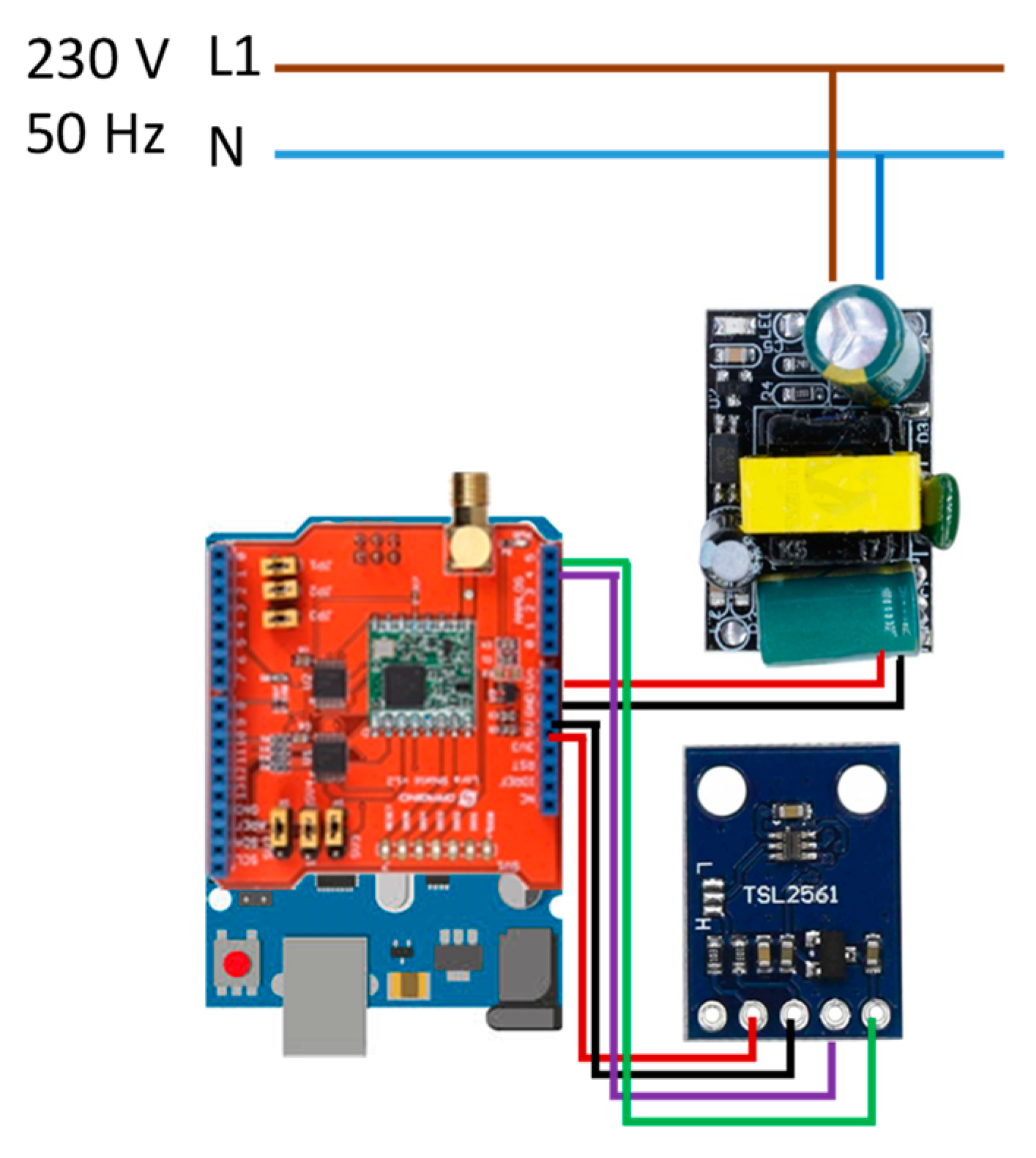
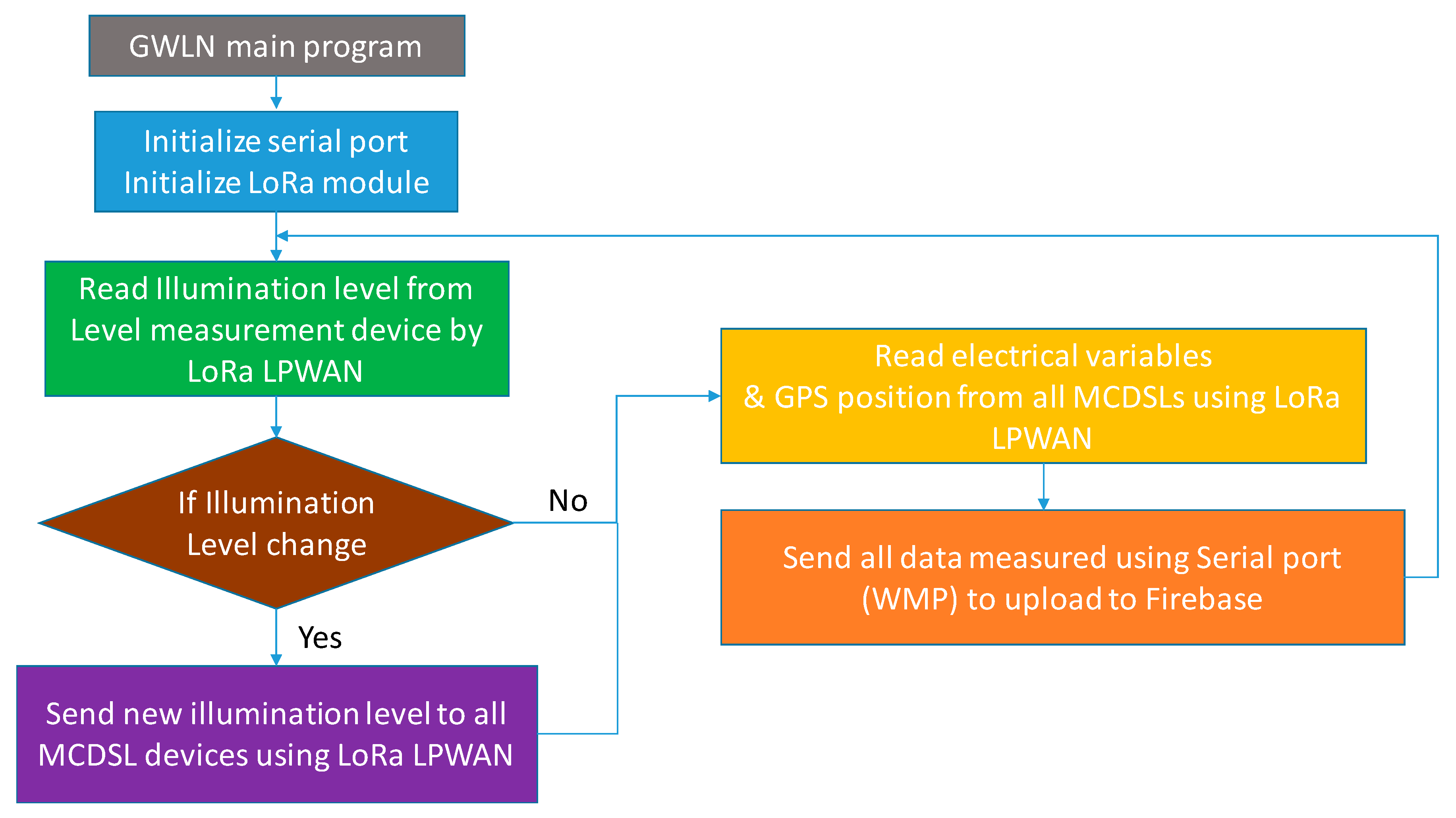
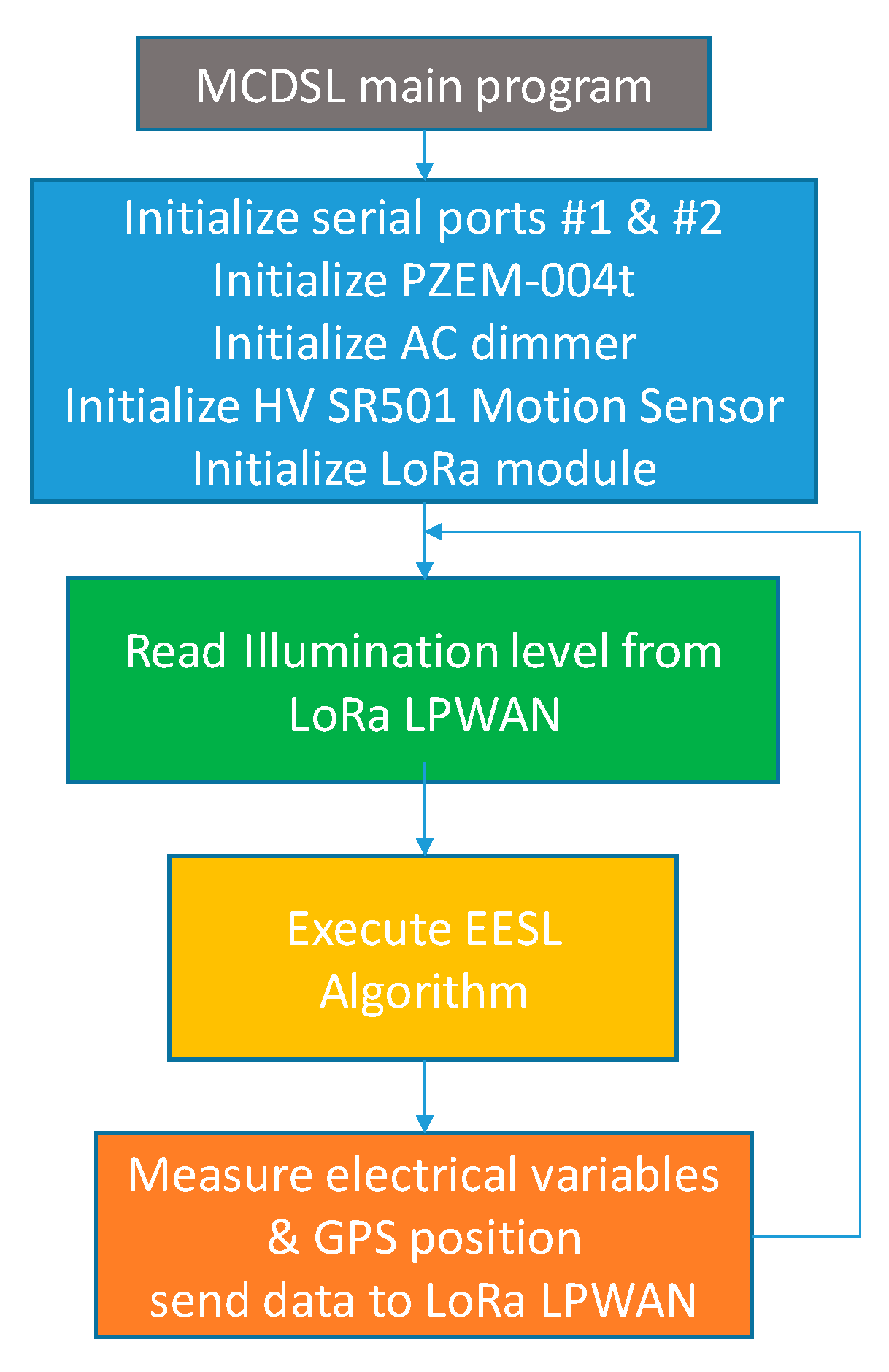
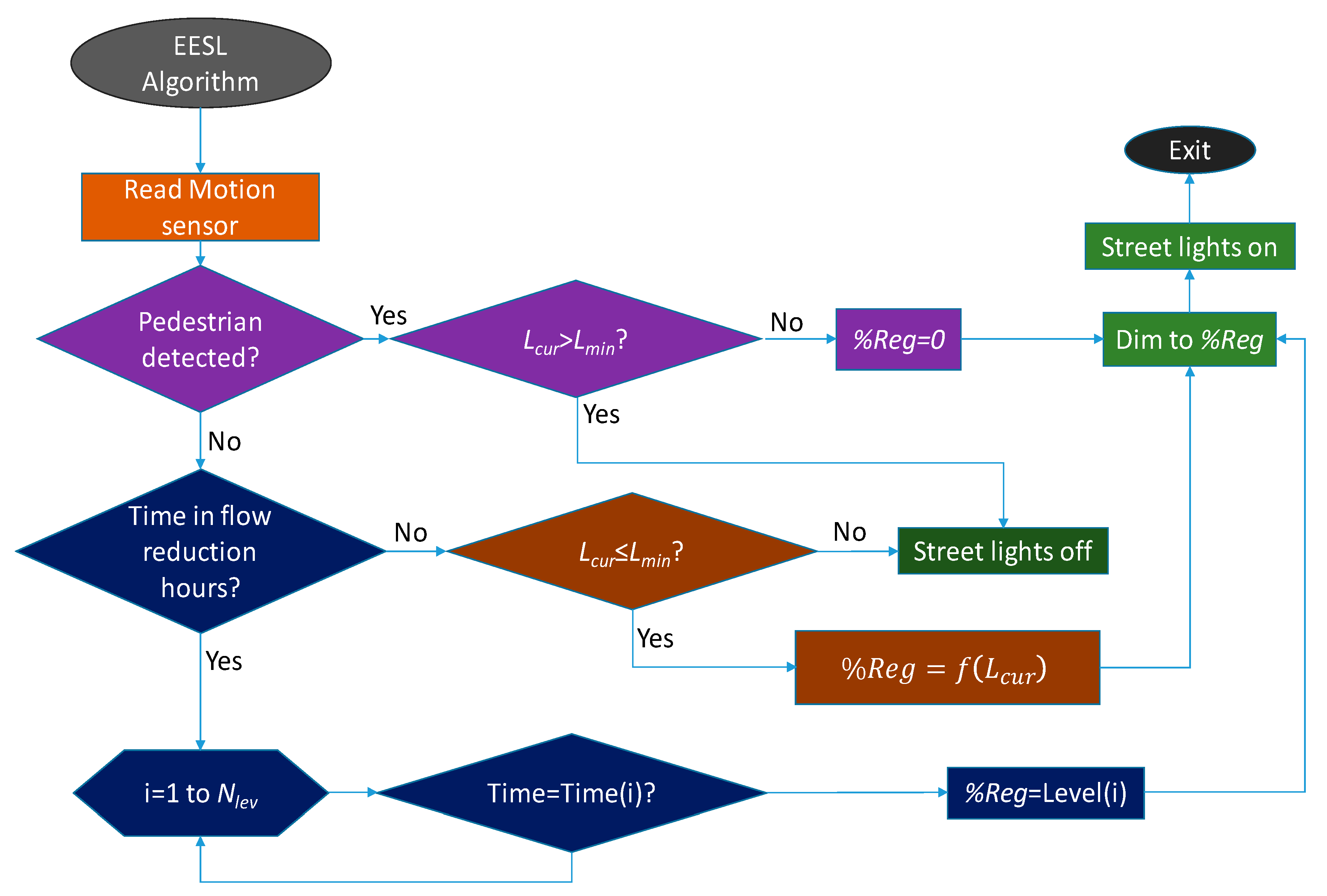
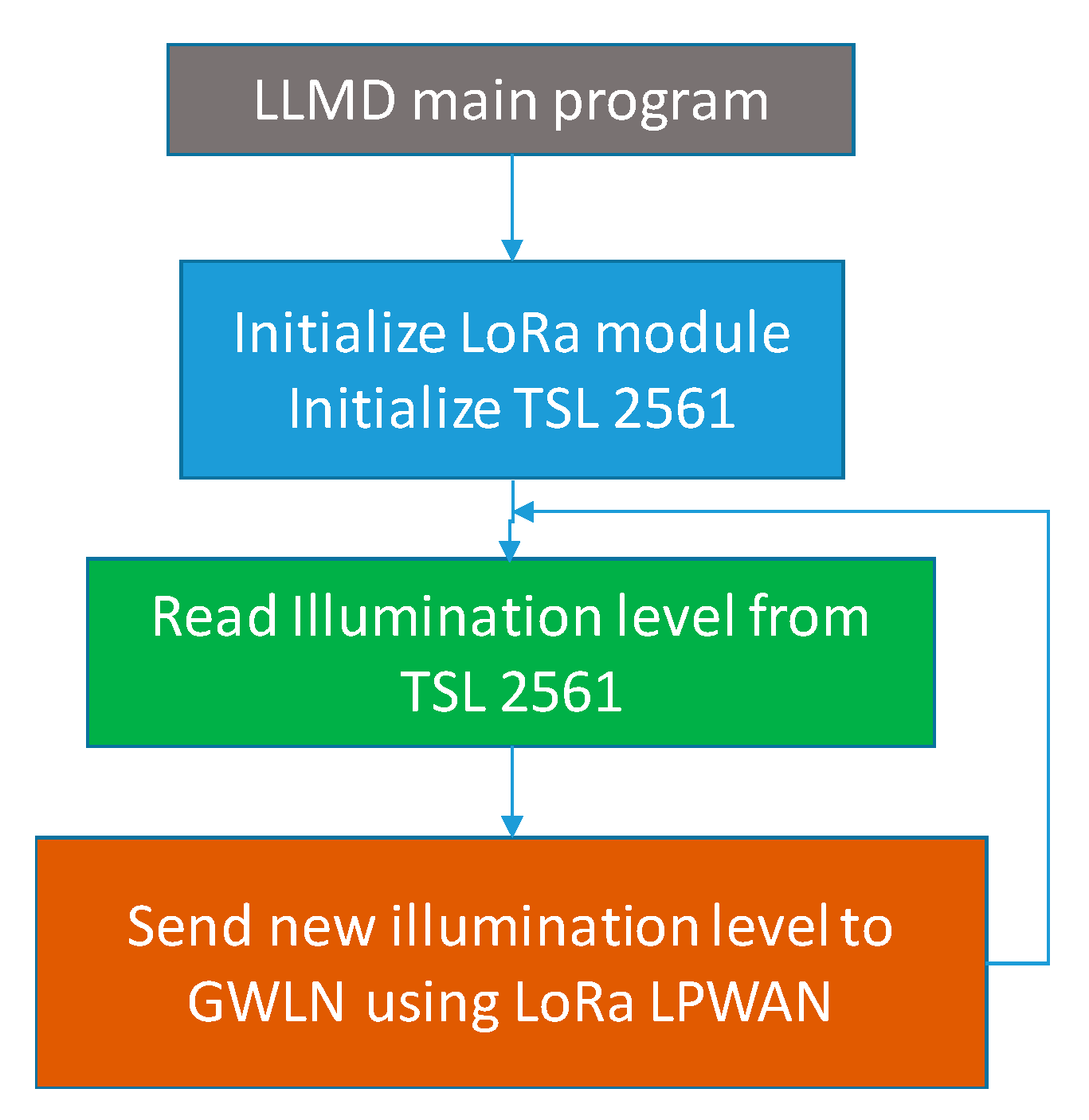
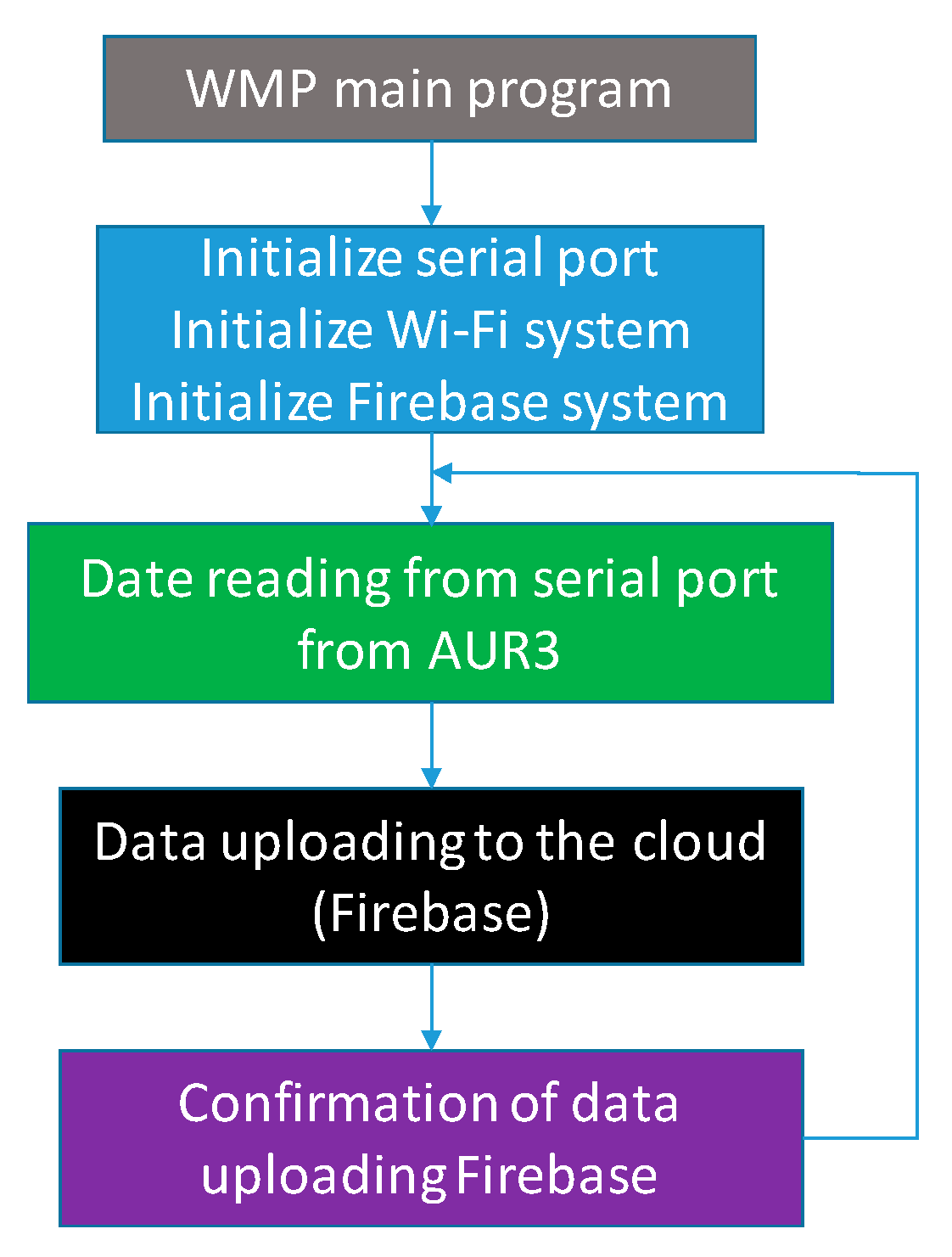

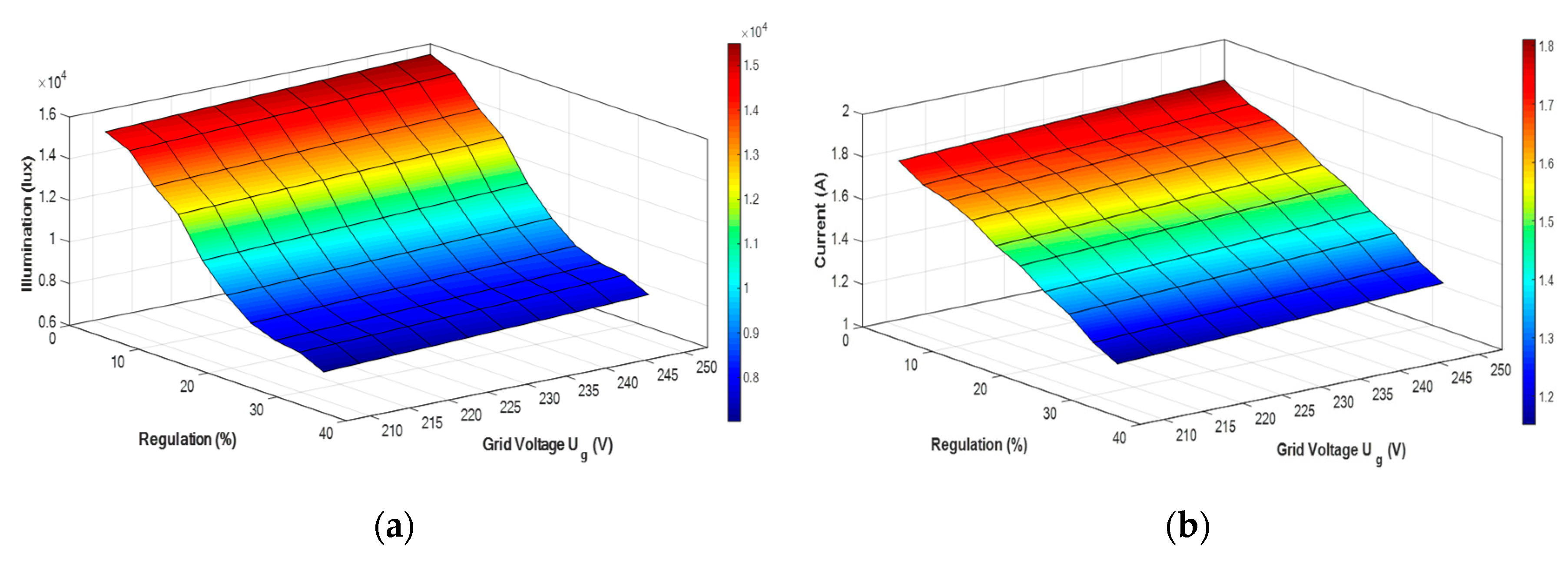
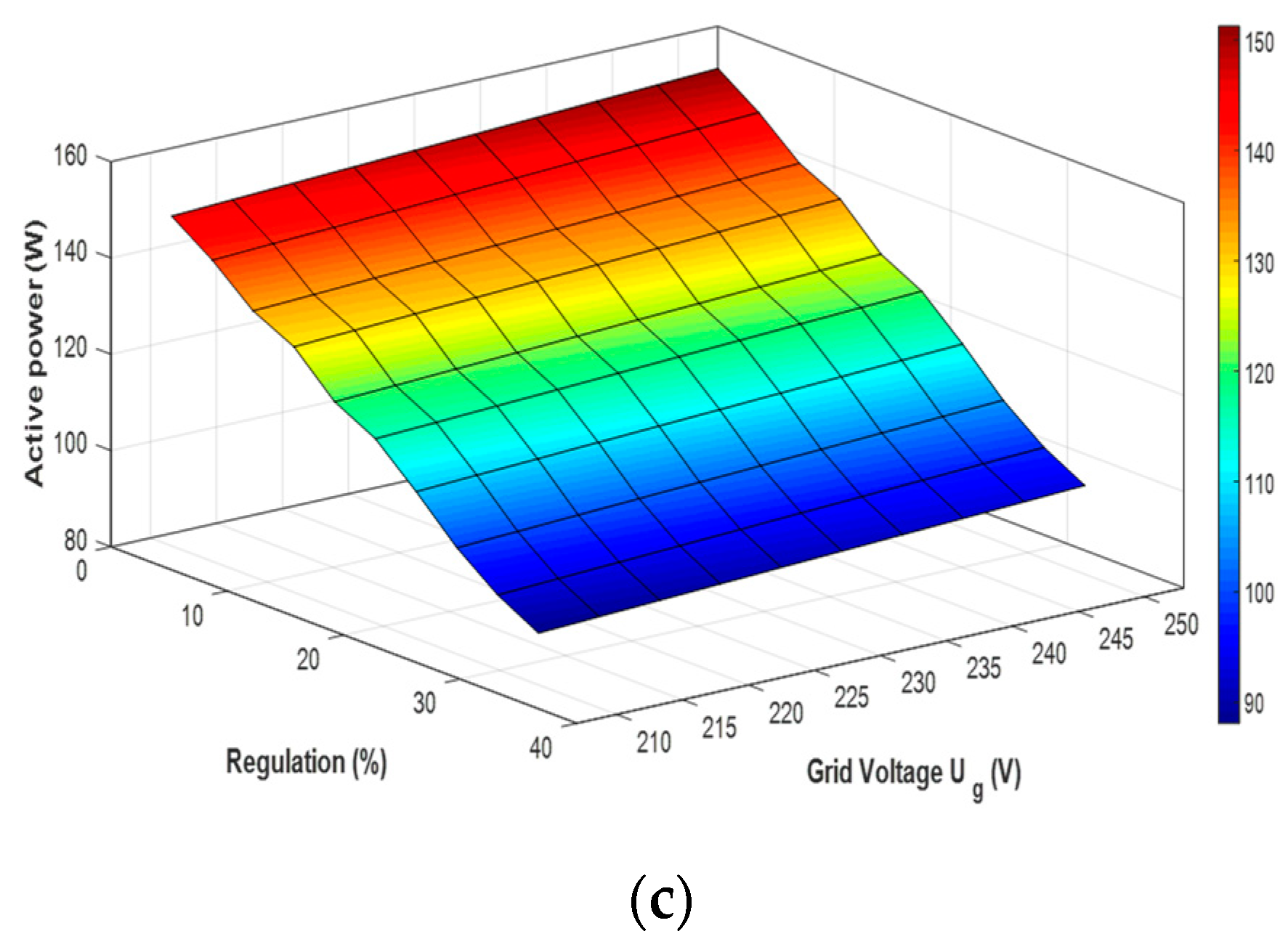
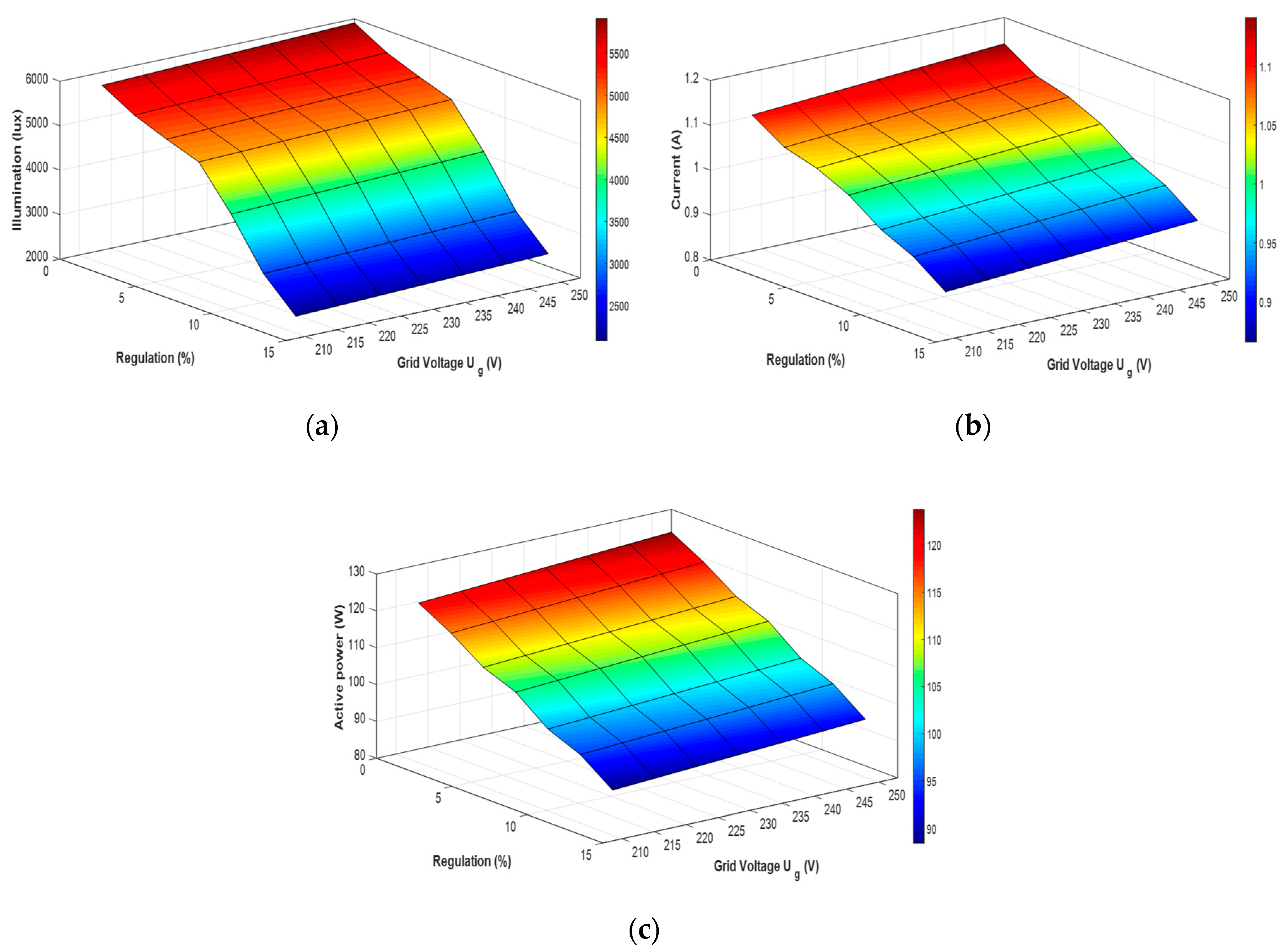

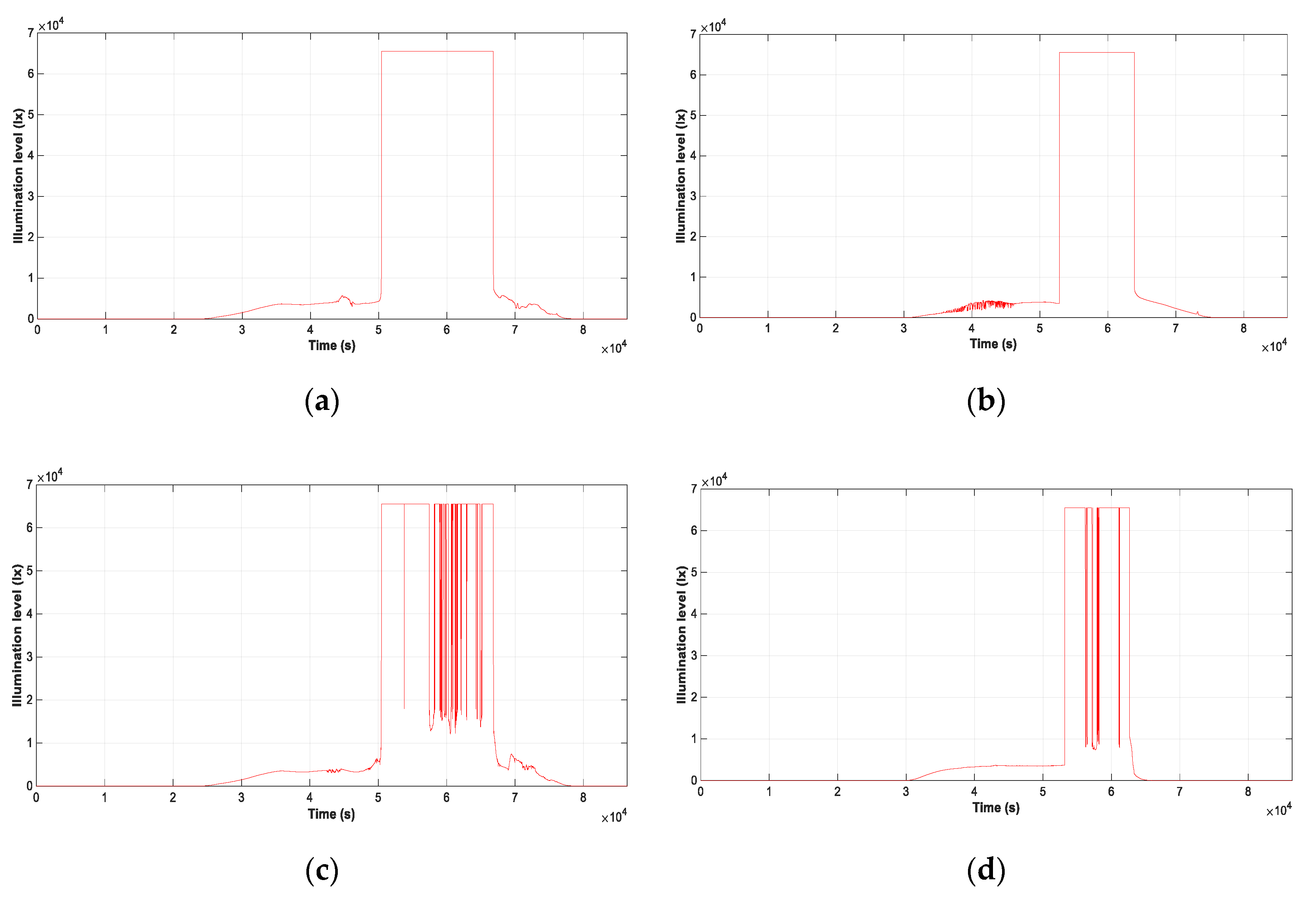
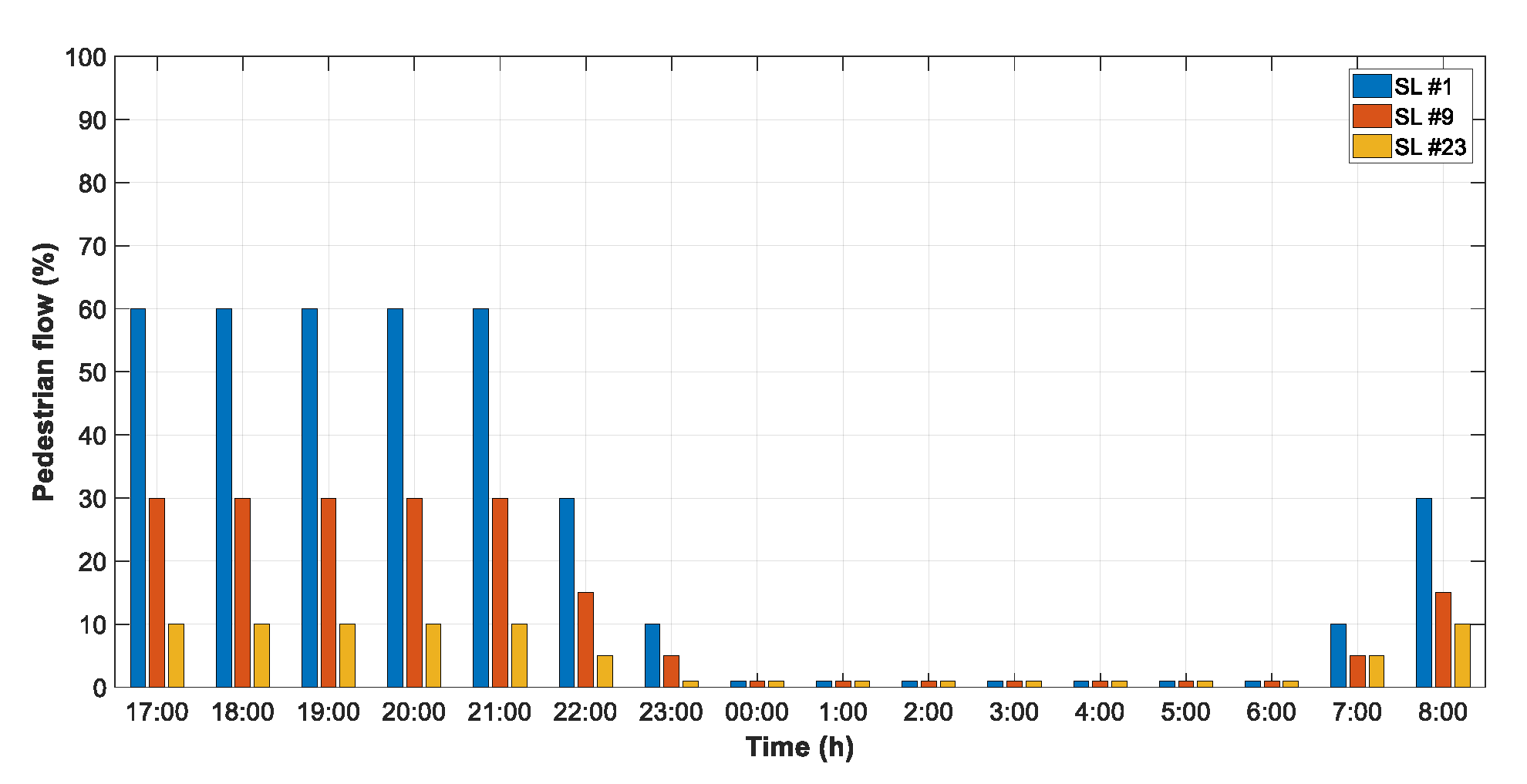
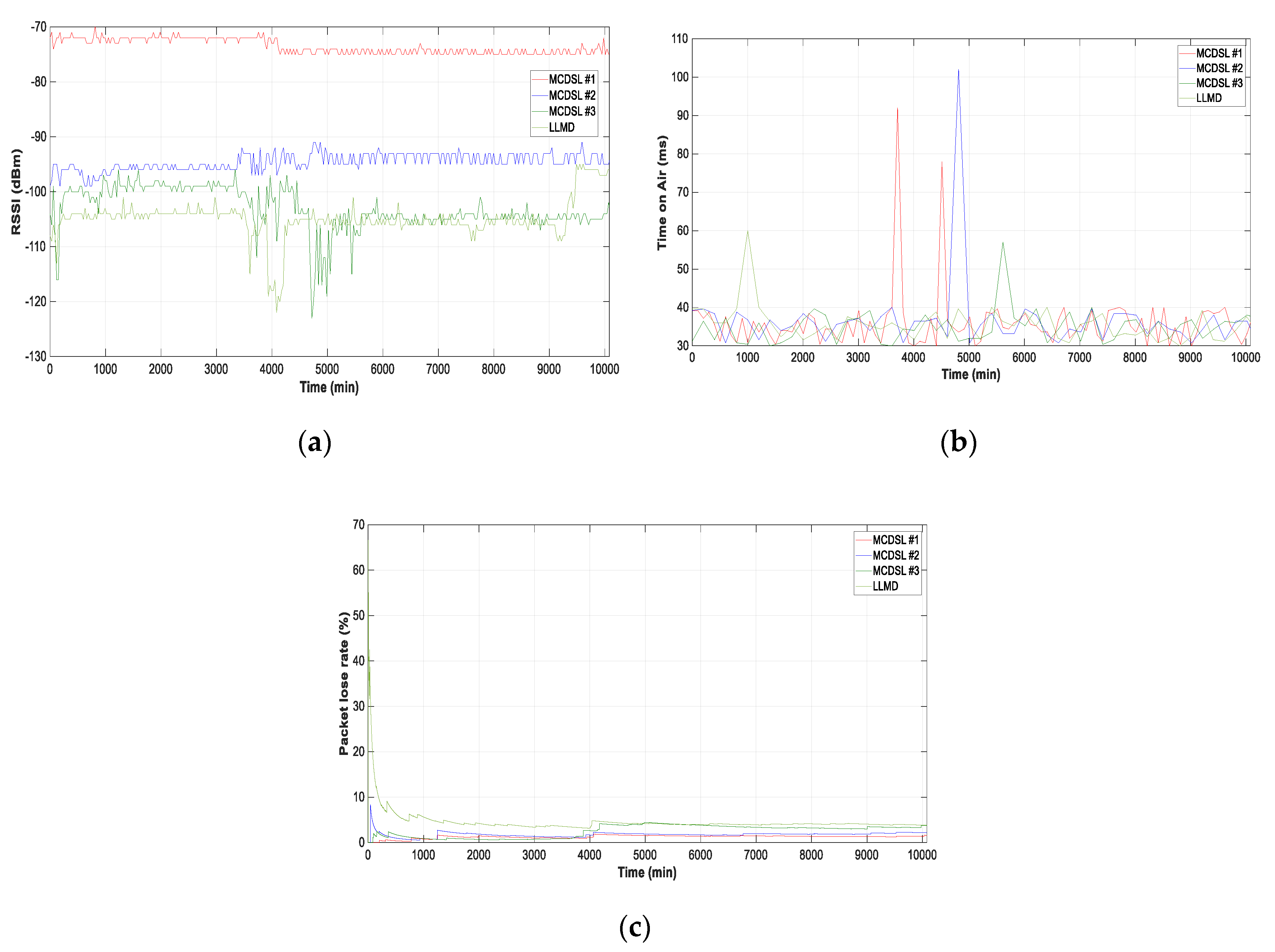
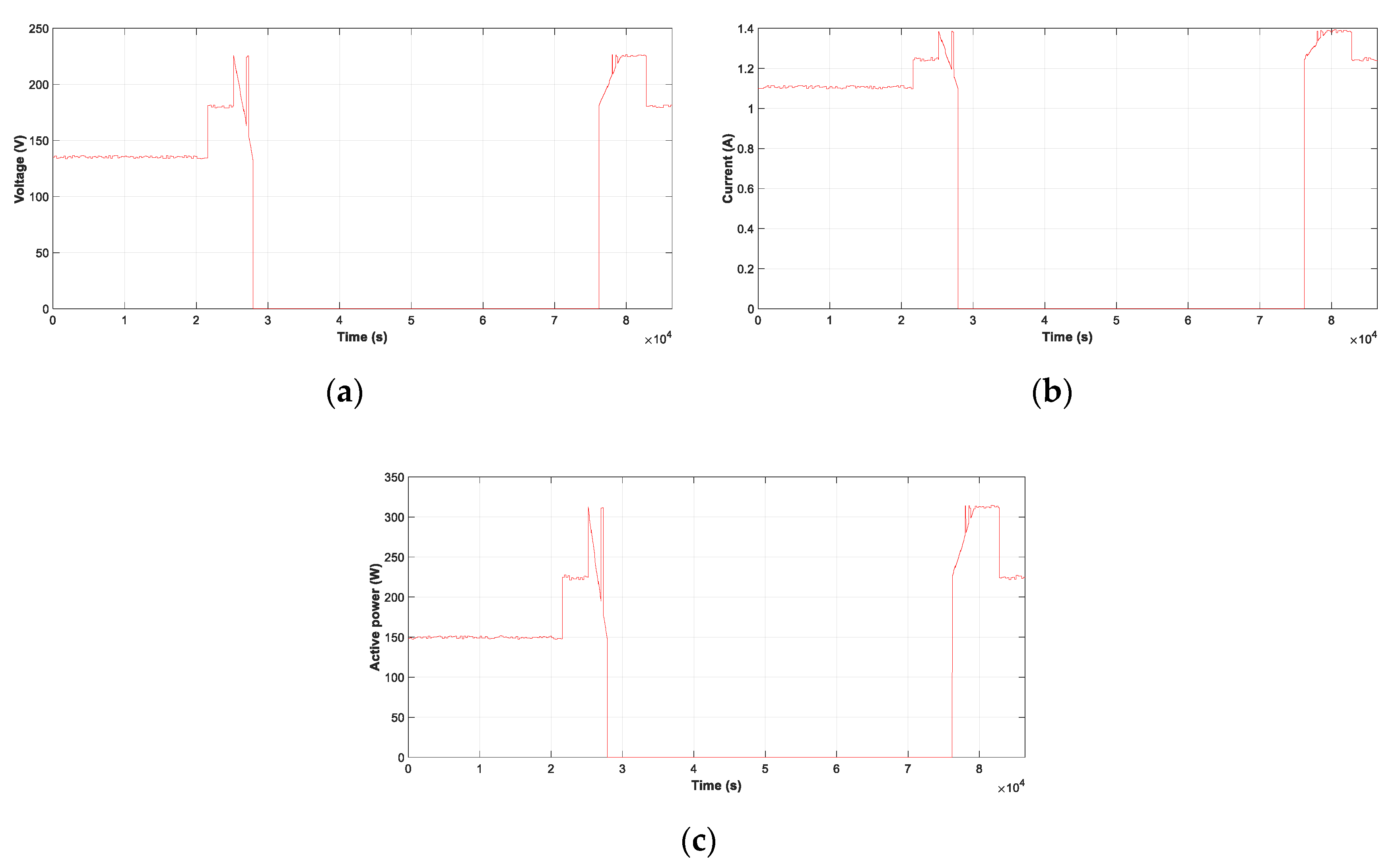
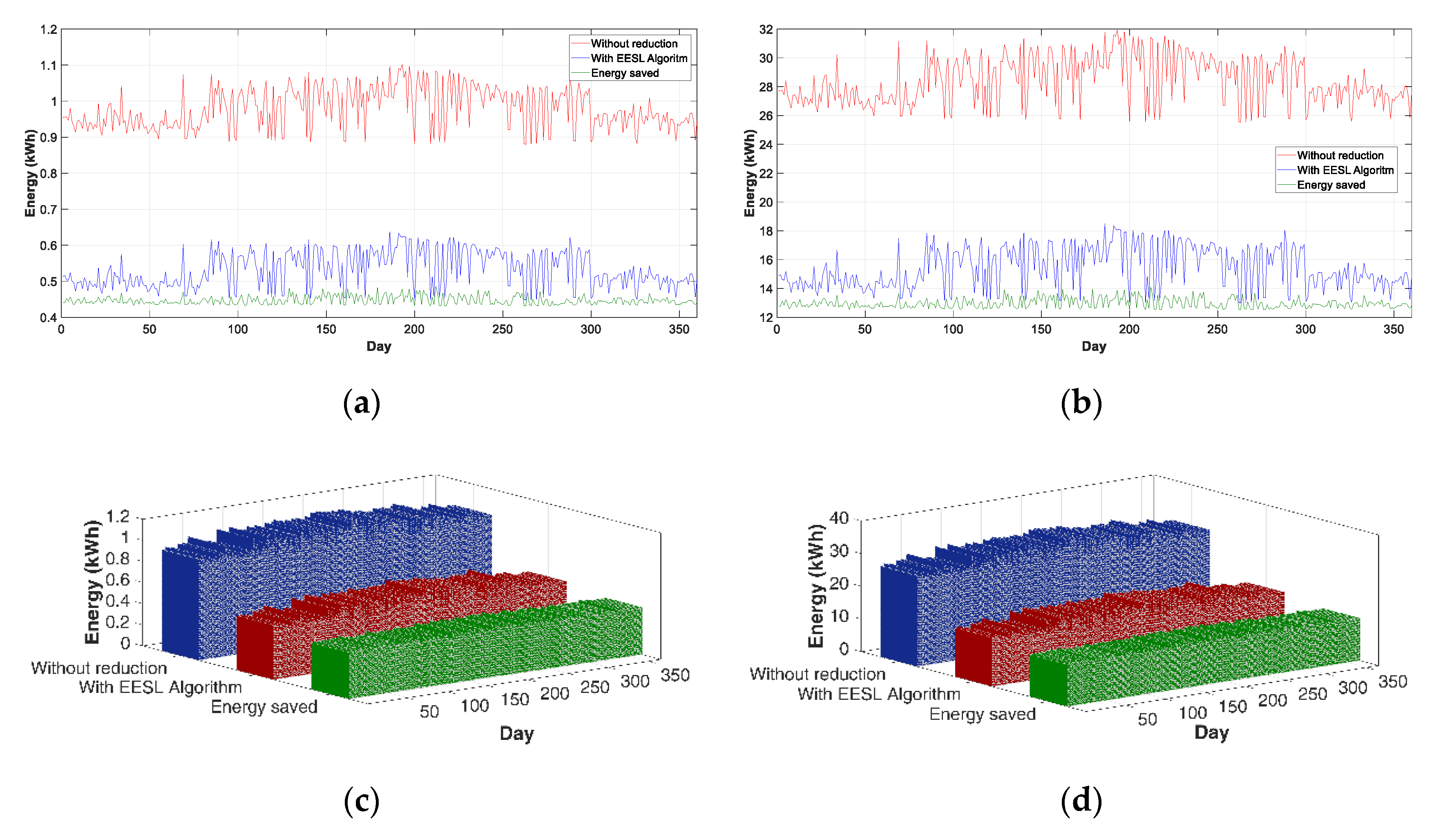
| Bibliography | Parameters Measured | Network Technologies | Sensors | Based on |
|---|---|---|---|---|
| [12] | Electrical parameters | Wi-Fi | Not provided | CC2530OEM module |
| [13] | Weather parameters, Object detection | SIM900/GSM/SMS | PIR Sensor Dust Sensor Rain Sensor | Arduino |
| [14] | Light intensity, | Not provided | Lighting Sensor Motion Sensor PIR Sensor | Not provided |
| [15] | Object detection, Light intensity | Not provided | IR Sensor LDR | Arduino Uno |
| [16] | Illumination level | Not provided | KNX Basic weather station | Not provided |
| [17] | Illumination level | Not provided | Ambient light sensor | Not provided |
| [18] | Local presence | LPWAN | Road-user sensor | Not provided |
| [19] | Light intensity | Not provided | IR sensor, PIR sensors | Atmega128 |
| [20] | Presence detector, Light intensity | LPWAN | PIR sensors, LDR, ISL76671, RADAR sensor | Westermo GDW-11 485 GSM |
| [21] | Electric parameters, Light intensity | ZigBee | MAVOLUX 5032 B | Not provided |
| [22] | Electric and weather parameters, Ambient light | LPWAN | Not provided | PLC |
| [23] | Humidity, temperature, light and infrared sensor | LPWAN | 808H5V5, MCP9700A, EKMC, LDR | ATmega1281 |
| [24] | Lux and Temp sensor | L-INX | Not provided | PLC |
| [25] | Presence sensor | WiMAX | Not provided | Raspberry-Pi |
| [26] | Electrical parameters, Luminance | Not provided | Orthoimages | GIS |
| [27] | Illumination level | LPWAN | Not provided | EMB-LR1272 |
| Class | Horizontal Illuminance | Additional Requirements | ||
|---|---|---|---|---|
| Horizontal Illuminance E (lux) | Minimum Horizontal Illuminance Emin (lux) | Minimum Vertical Illuminance Ev,min (lux) | Minimum Semicylindrical Illuminance Esc,min (lux) | |
| P1 | 15.0 | 3.00 | 5.00 | 5.00 |
| P2 | 10.0 | 2.00 | 3.00 | 2.00 |
| P3 | 7.50 | 1.50 | 2.50 | 1.50 |
| P4 | 5.00 | 1.00 | 1.50 | 1.00 |
| P5 | 3.00 | 0.60 | 1.00 | 0.60 |
| P6 | 2.00 | 0.40 | 0.60 | 0.20 |
| Description | Number | Unit Price (€) | Total Price (€) |
|---|---|---|---|
| Microcontroller AUR3 | 1 | 20.00 | 20.00 |
| Lora shield for Arduino DLS | 1 | 22.91 | 22.91 |
| Microcontroller WMP | 1 | 4.61 | 4.61 |
| Power supply unit | 1 | 1.78 | 1.78 |
| Box container | 1 | 6.98 | 6.98 |
| auxiliary material and wiring | 1 | 1.45 | 1.45 |
| Total cost | 57.63 |
| Description | Number | Unit Price (€) | Total Price (€) |
|---|---|---|---|
| Microcontroller AUM3 | 1 | 28.00 | 28.00 |
| Lora GPS shield for Arduino DLGS | 1 | 35.90 | 35.90 |
| PZEM-004t | 1 | 10.08 | 10.08 |
| AC Dimmer | 1 | 3.22 | 3.22 |
| Motion sensor HC SR501 | 1 | 1.53 | 1.53 |
| Power supply unit | 1 | 1.78 | 1.78 |
| Box container | 1 | 6.98 | 6.98 |
| auxiliary material and wiring | 1 | 2.03 | 2.03 |
| Total cost | 89.52 |
| Description | Number | Unit Price (€) | Total Price (€) |
|---|---|---|---|
| Microcontroller AUR3 | 1 | 20.00 | 20.00 |
| Lora shield for Arduino DLS | 1 | 22.91 | 22.91 |
| Illumination sensor TSL2561 | 1 | 3.76 | 3.76 |
| Power supply unit | 1 | 1.78 | 1.78 |
| Box container | 1 | 6.98 | 6.98 |
| auxiliary material and wiring | 1 | 1.05 | 1.05 |
| Total cost | 56.48 |
| Distance (m) | LLMD | Konica Minolta | Measuring Error (ε) | ||||||
|---|---|---|---|---|---|---|---|---|---|
| CDO (lx) | SON (lx) | HPS (lx) | CDO (lx) | SON (lx) | HPS (lx) | CDO (%) | SON (%) | HPS (%) | |
| 1 | 1024.564 | 2196.874 | 675.304 | 1026.719 | 2203.661 | 675.408 | 0.216 | 0.010 | 0.679 |
| 2 | 830.000 | 719.511 | 195.838 | 822.829 | 720.931 | 197.047 | 0.717 | 0.121 | 0.142 |
| 3 | 294.286 | 408.264 | 108.038 | 294.916 | 408.671 | 107.993 | 0.063 | 0.040 | 0.041 |
| 4 | 158.018 | 278.451 | 70.670 | 158.352 | 279.267 | 71.006 | 0.033 | 0.034 | 0.082 |
| 5 | 103.313 | 211.026 | 60.251 | 102.827 | 210.653 | 61.024 | 0.049 | 0.077 | 0.037 |
| 6 | 68.429 | 172.416 | 48.830 | 68.322 | 171.608 | 48.603 | 0.011 | 0.023 | 0.081 |
| 7 | 46.000 | 130.901 | 32.272 | 46.236 | 131.437 | 32.093 | 0.024 | 0.018 | 0.054 |
| Device | Place | UTM Coordinates Zone 30 | |
|---|---|---|---|
| X (m) | Y (m) | ||
| MCDSL #1 | SL #1 | 431,300 | 4,182,653 |
| MCDSL #2 | SL #9 | 431,408 | 4,182,749 |
| MCDSL #3 | SL #23 | 431,320 | 4,182,808 |
| LLMD | Terrace of administration building | 431,308 | 4,182,777 |
| Device | RSSI (dBm) | Time on Air (ms) | Packets Lost Rate (%) | |||
|---|---|---|---|---|---|---|
| µ | σ | µ | σ | µ | σ | |
| MCDSL #1 | −73.430 | 1.511 | 34.989 | 2.991 | 1.352 | 0.235 |
| MCDSL #2 | −94.853 | 1.679 | 34.997 | 3.007 | 2.029 | 0.393 |
| MCDSL #3 | −102.936 | 2.990 | 34.983 | 2.998 | 3.158 | 0.958 |
| LLMD | −101.417 | 3.892 | 35.001 | 3.020 | 3.750 | 1.967 |
| Device | Packet Send | Packet Delivery | Packet Lost | Packets Delivery Rate (%) |
|---|---|---|---|---|
| MCDSL #1 | 30240 | 29831 | 409 | 98.65 |
| MCDSL #2 | 30240 | 29626 | 614 | 97.97 |
| MCDSL #3 | 30240 | 29285 | 955 | 96.84 |
| LLMD | 30240 | 29106 | 1134 | 96.25 |
| Type | NSL | ESL | Esav |
|---|---|---|---|
| EESL Algorithm | 29 | 6.126 | 117.654 |
| Flow reduction 40% (0:00–6:00) | 134.685 | 3436.587 | |
| Flow reduction 20% (23:00–0:00, 6:00–7:00) | 22.265 | 645.685 | |
| Total | 4259.926 |
© 2020 by the authors. Licensee MDPI, Basel, Switzerland. This article is an open access article distributed under the terms and conditions of the Creative Commons Attribution (CC BY) license (http://creativecommons.org/licenses/by/4.0/).
Share and Cite
Sánchez Sutil, F.; Cano-Ortega, A. Smart Public Lighting Control and Measurement System Using LoRa Network. Electronics 2020, 9, 124. https://doi.org/10.3390/electronics9010124
Sánchez Sutil F, Cano-Ortega A. Smart Public Lighting Control and Measurement System Using LoRa Network. Electronics. 2020; 9(1):124. https://doi.org/10.3390/electronics9010124
Chicago/Turabian StyleSánchez Sutil, F., and Antonio Cano-Ortega. 2020. "Smart Public Lighting Control and Measurement System Using LoRa Network" Electronics 9, no. 1: 124. https://doi.org/10.3390/electronics9010124
APA StyleSánchez Sutil, F., & Cano-Ortega, A. (2020). Smart Public Lighting Control and Measurement System Using LoRa Network. Electronics, 9(1), 124. https://doi.org/10.3390/electronics9010124






